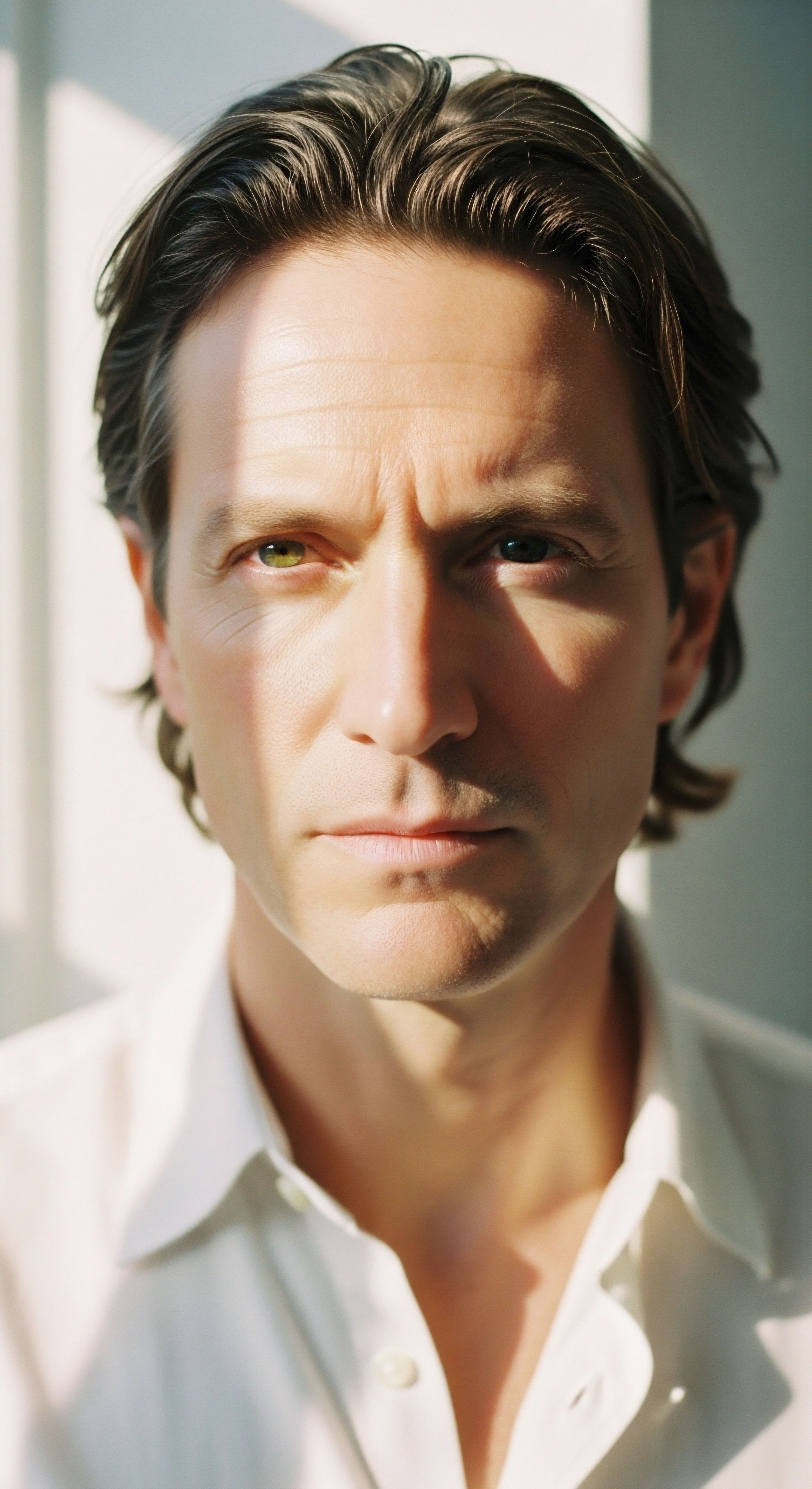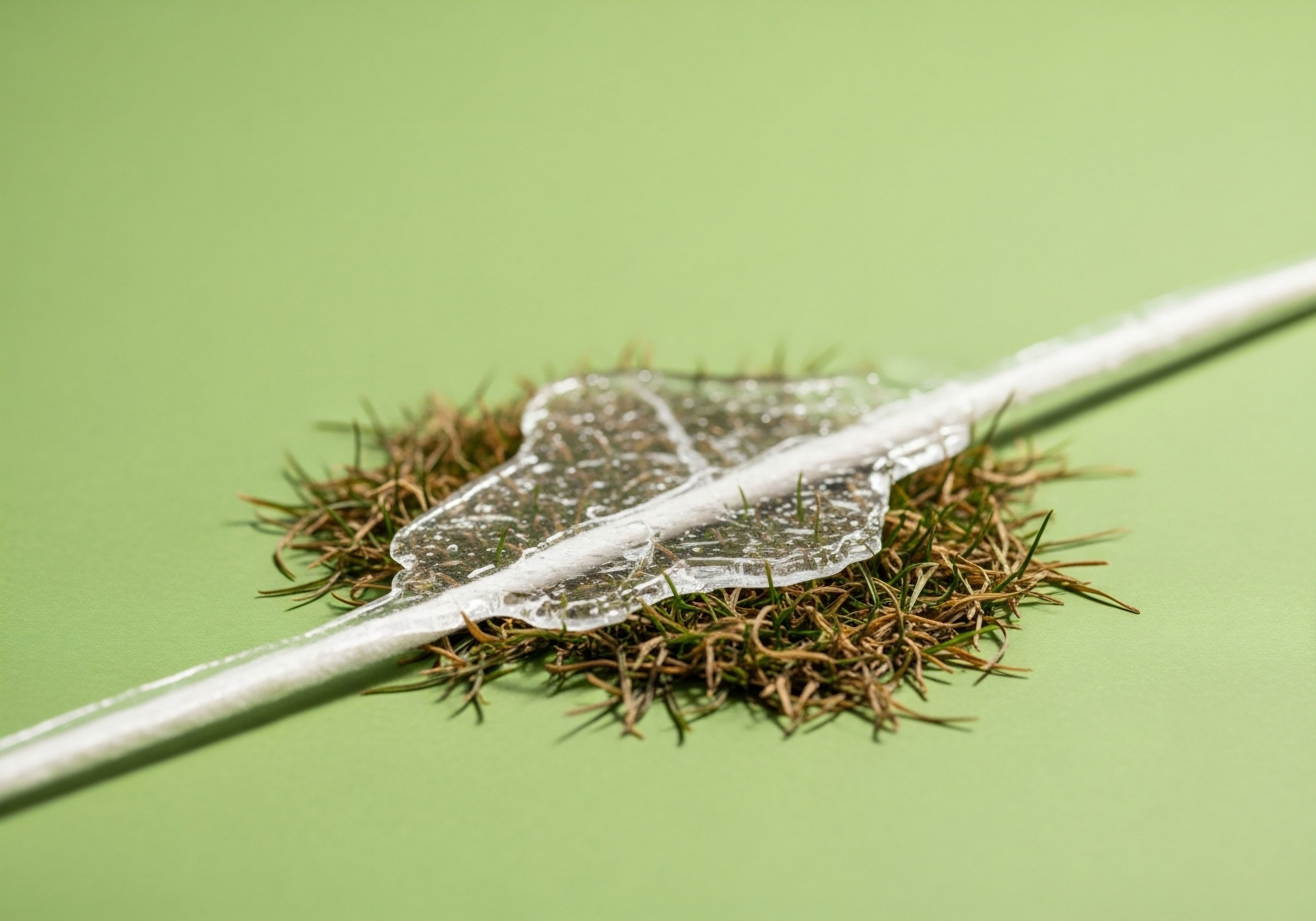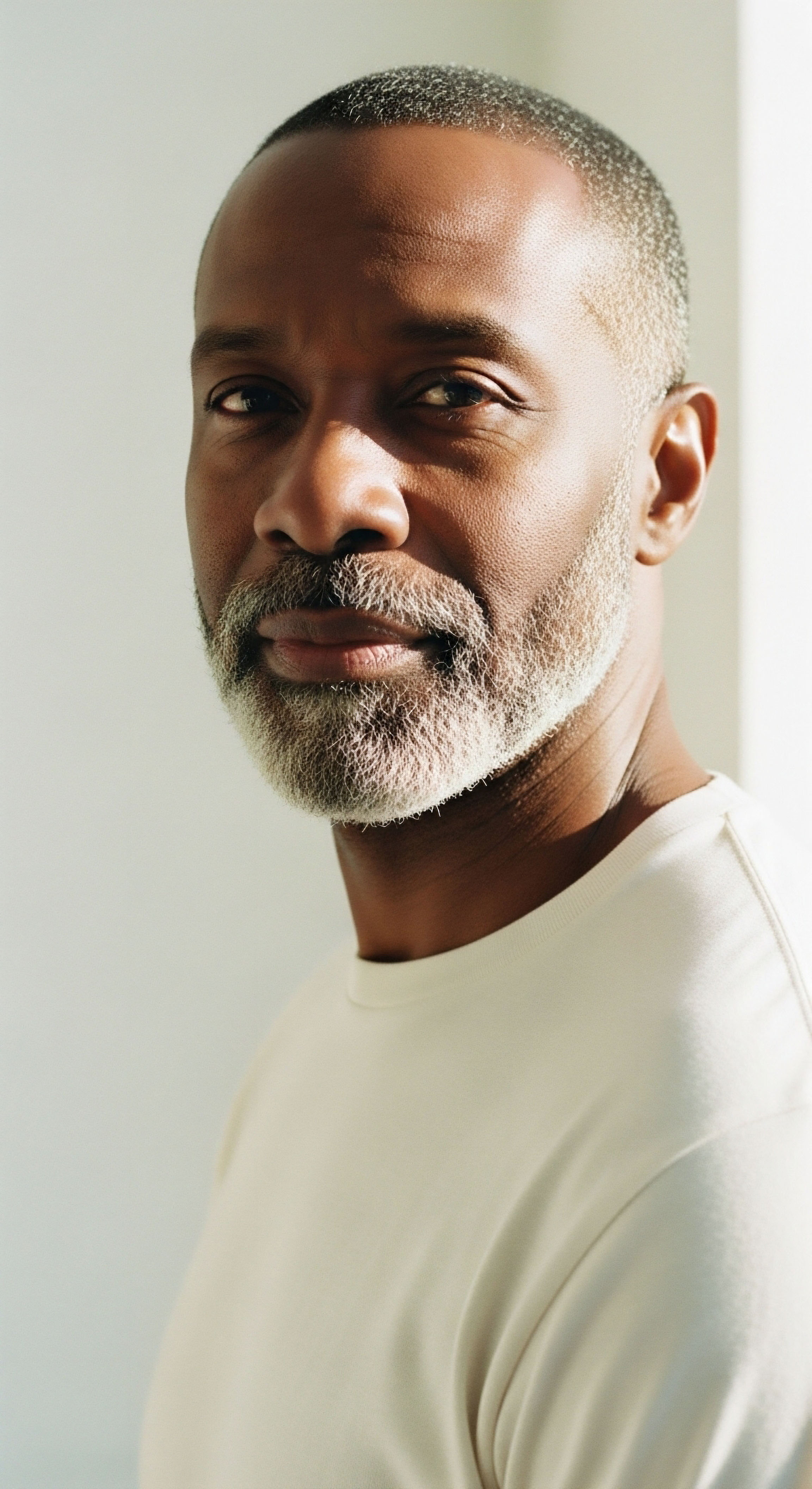

Fundamentals
You have likely sensed a paradox in the pursuit of peak physical condition. A feeling that pushing your body to its absolute limit, while celebrated in fitness culture, might come at a cost to your fundamental vitality. This intuition is correct. The relationship between physical activity and male hormonal health is best visualized as a U-shaped curve.
At one end, a sedentary lifestyle creates a cascade of metabolic issues that quietly undermine fertility and testosterone production. At the other extreme, excessive, high-intensity exercise generates a different, more acute set of biological stressors that can suppress the very systems you are trying to optimize.
The question is not about which is simply “worse.” The relevant exploration is understanding how these two distinct paths lead to a similar destination of compromised function, and how to find the powerful, life-affirming middle ground.
A sedentary existence promotes a state of low-grade, chronic inflammation and often leads to an increase in adipose tissue, or body fat. This fat tissue is metabolically active, producing enzymes like aromatase which converts testosterone into estrogen, thereby lowering free testosterone levels.
Inactivity also contributes to insulin resistance, a condition where your body’s cells become less responsive to the hormone insulin. This metabolic dysfunction is directly linked to poorer sperm quality and diminished hormonal output from the testes. The body, in this state, is under a quiet, systemic siege from metabolic inefficiency.
Both physical inactivity and overtraining can disrupt the delicate hormonal symphony required for optimal male reproductive health.
Conversely, the body interprets relentless, high-volume exercise as a state of crisis. This triggers the release of stress hormones like cortisol. Elevated cortisol directly suppresses the signaling cascade that commands the testes to produce testosterone. This phenomenon is a protective mechanism; the body is prioritizing immediate survival over long-term reproductive capability.
When this state becomes chronic, it can lead to a clinically recognized state known as exercise-induced hypogonadism, where testosterone levels fall, impacting everything from libido to sperm production. The challenge lies in applying a dose of physical stress that stimulates adaptation and growth, without overwhelming the system’s capacity to recover and regulate itself.

The Productive Middle Ground
Moderate, consistent exercise offers a powerful antidote to the issues plaguing both ends of the spectrum. Engaging in regular physical activity improves insulin sensitivity, reduces harmful adipose tissue, and lowers systemic inflammation. Studies have shown that men who exercise moderately tend to have higher testosterone levels and better semen parameters, including sperm concentration and motility, compared to their sedentary counterparts.
This level of activity also enhances the body’s own antioxidant defenses, protecting sperm from the DNA damage caused by oxidative stress. The goal is to view exercise as a potent form of medicine, one that requires a precise and personalized dosage to achieve its profound benefits without inducing toxicity.


Intermediate
To comprehend how both a lack of movement and an excess of it can derail male fertility, we must examine the body’s master regulatory circuit for reproductive health ∞ the Hypothalamic-Pituitary-Gonadal (HPG) axis. This is a sophisticated three-way communication system. The hypothalamus in the brain releases Gonadotropin-Releasing Hormone (GnRH).
This chemical messenger travels to the pituitary gland, instructing it to release two more hormones ∞ Luteinizing Hormone (LH) and Follicle-Stimulating Hormone (FSH). LH travels through the bloodstream to the Leydig cells in the testes, giving the direct command to produce testosterone.
FSH, concurrently, acts on the Sertoli cells within the testes, which are responsible for spermatogenesis, the creation of sperm. This entire system operates on a sensitive feedback loop; when testosterone levels are sufficient, they signal back to the hypothalamus and pituitary to slow down GnRH, LH, and FSH release, maintaining a state of equilibrium.

How Different Stressors Disrupt the HPG Axis
A sedentary lifestyle disrupts the HPG axis primarily through downstream metabolic consequences. Obesity and insulin resistance create a hormonal environment that interferes with the axis’s function. Increased body fat leads to higher levels of aromatase activity, converting testosterone to estradiol. Elevated estradiol then sends a potent negative feedback signal to the pituitary and hypothalamus, suppressing LH and FSH production and, consequently, reducing the testicular drive to produce testosterone. The system is being dampened by metabolic noise.
Excessive exercise, on the other hand, attacks the HPG axis from the top down. The immense physiological stress of overtraining elevates cortisol, the primary stress hormone. Cortisol has a direct inhibitory effect on the hypothalamus, reducing its output of GnRH. With less GnRH, the entire downstream cascade is throttled.
The pituitary releases less LH and FSH, leading to reduced testosterone production and impaired sperm maturation. This is a central shutdown of the system, a conscious energy-saving decision by the brain in response to perceived danger. This condition is often referred to as exercise-induced hypogonadism.
The HPG axis is the central command for male reproductive function, and its disruption is a common outcome of both extreme inactivity and overexertion.
The table below contrasts the primary mechanisms of hormonal disruption in these two states.
| Factor | Sedentary Lifestyle Impact | Excessive Exercise Impact |
|---|---|---|
| HPG Axis Disruption | Primarily peripheral and downstream; increased aromatization from adipose tissue creates negative feedback. | Primarily central and upstream; elevated cortisol directly suppresses hypothalamic GnRH release. |
| Primary Hormonal Driver | Increased insulin resistance and elevated estradiol from testosterone conversion. | Elevated cortisol and other stress-related hormones. |
| Testosterone Levels | Often decreased due to higher conversion to estrogen and metabolic dysfunction. | Decreased due to central suppression of the HPG axis. |
| Inflammation | Characterized by chronic, low-grade systemic inflammation. | Marked by acute and chronic inflammation from muscle damage and systemic stress. |
| Sperm Quality | Negatively affected by metabolic syndrome, obesity, and associated oxidative stress. | Impaired by hormonal suppression, elevated scrotal temperature, and high oxidative stress. |

Restoring the System after Overtraining
For individuals whose hormonal balance and fertility have been compromised by excessive training, a specific clinical approach is required. The primary intervention is a significant reduction in training volume and intensity, coupled with nutritional support to address any energy deficit. For men seeking to actively restore fertility, a protocol may be initiated to restart the HPG axis.
This can involve medications like Gonadorelin, a synthetic version of GnRH, to stimulate the pituitary directly. Clomiphene Citrate (Clomid) or Tamoxifen may also be used to block estrogen receptors at the hypothalamus, tricking the brain into sensing low estrogen and increasing its output of GnRH, LH, and FSH. This protocol is designed to reboot the entire axis, encouraging the testes to resume their natural testosterone and sperm production.


Academic
The clinical presentation of suppressed testicular function in endurance athletes, termed the “Exercise-Hypogonadal Male Condition,” represents a fascinating case of adaptive physiology that becomes maladaptive. This is a state distinct from primary or secondary hypogonadism caused by pathology. It is an integrated neuroendocrine response to a sustained energy drain and physical stress.
Research indicates that the etiology is multifactorial, involving not just the suppression of the HPG axis via cortisol, but also the contribution of chronic inflammation and elevated oxidative stress, which collectively degrade testicular function and semen quality. The body, perceiving a threat to survival from extreme energy expenditure, strategically de-prioritizes the metabolically expensive process of reproduction.

The Molecular Impact of Oxidative Stress
While moderate exercise enhances endogenous antioxidant systems, excessive training overwhelms them. Intense, prolonged workouts generate a surge of reactive oxygen species (ROS). When ROS production outstrips the body’s antioxidant capacity, a state of oxidative stress ensues. Spermatozoa are uniquely vulnerable to oxidative damage.
Their plasma membranes are rich in polyunsaturated fatty acids, which are highly susceptible to lipid peroxidation by ROS. This damage impairs membrane fluidity and function, which is critical for sperm motility and the ability to fertilize an oocyte. Furthermore, oxidative stress can cause direct damage to sperm DNA, leading to strand breaks and mutations that can compromise embryo viability.
This cellular-level damage is a significant contributor to the decline in fertility seen in overtrained athletes, independent of the systemic hormonal suppression.

What Is the True Prevalence of the Exercise Hypogonadal Male Condition?
A critical gap in the literature is a comprehensive epidemiological investigation into the prevalence of the Exercise-Hypogonadal Male Condition. While the phenomenon is well-documented in case studies and small cohort studies of elite athletes, its prevalence in the broader population of serious amateur athletes is unknown.
The condition is defined by persistently low resting testosterone levels without the compensatory rise in Luteinizing Hormone (LH) that would typically be seen in primary testicular failure. This lack of an LH surge points to a central, regulatory suppression at the level of the hypothalamus or pituitary, consistent with the model of functional hypogonadism. Differentiating between a transient state of overreaching and this more chronic condition is a key diagnostic challenge.
The Exercise-Hypogonadal Male Condition is a functional, adaptive suppression of the reproductive axis, yet its long-term health implications remain under investigation.
The following table outlines key biomarkers used to differentiate between a healthy athletic state, a sedentary state, and an overtrained, hypogonadal state.
| Biomarker | Healthy Moderately Active Male | Sedentary Male (with metabolic dysfunction) | Male with Exercise-Induced Hypogonadism |
|---|---|---|---|
| Total Testosterone | Normal to high-normal range. | Low-normal to low range. | Persistently low-normal to low range. |
| Free Testosterone | Optimal range. | Often low due to elevated SHBG and aromatization. | Low. |
| Luteinizing Hormone (LH) | Normal pulsatile release. | Normal or slightly suppressed by elevated estradiol. | Inappropriately normal or low (no compensatory rise). |
| Cortisol | Normal diurnal rhythm. | May be dysregulated. | Chronically elevated basal levels. |
| Inflammatory Markers (e.g. hs-CRP) | Low. | Chronically elevated (low-grade). | Chronically elevated (from systemic stress). |
| Semen Parameters | Optimal count, motility, and morphology. | Often compromised due to metabolic factors. | Often compromised due to hormonal and oxidative stress. |

Is This Suppression a Dysfunction or an Adaptation?
One of the central academic debates is whether to frame this condition as a “dysfunction” or a “regulatory adjustment”. From a purely clinical perspective focused on reproductive health, it is a dysfunction. From a biological and evolutionary perspective, it can be viewed as a logical, protective adaptation.
The body is intelligently allocating finite resources away from procreation to preserve metabolic fuel for survival during a period of perceived famine and threat (represented by extreme caloric expenditure and physical stress). Understanding this dual perspective is key for both clinicians and athletes. It reframes the issue from a simple pathology to be “fixed” to a complex signaling problem that needs to be addressed by modifying the environmental inputs, namely, the balance between training load and recovery.
- Relative Energy Deficiency in Sport (RED-S) ∞ This term, coined by the International Olympic Committee, acknowledges that many of the hormonal disturbances seen in athletes are linked to a fundamental mismatch between energy intake and the energy expenditure of training. This low energy availability is a primary driver of HPG axis suppression in both male and female athletes.
- HPG Axis Plasticity ∞ The reproductive axis is not a static system. It demonstrates remarkable plasticity, adjusting its output based on a wide range of internal and external cues, including energy status, psychological stress, and inflammation. The exercise-hypogonadal state is a clear example of this plasticity in action.
- Long-Term Health Consequences ∞ While the immediate effects on fertility are clear, the long-term consequences of chronically low testosterone in this population are still being studied. Potential concerns include impacts on bone mineral density, mood, cognitive function, and cardiovascular health, mirroring the risks seen in other forms of hypogonadism.

References
- Hackney, A. C. & Koltun, K. J. (2020). Hypogonadism in Exercising Males ∞ Dysfunction or Adaptive-Regulatory Adjustment?. Frontiers in Endocrinology, 11, 123.
- Moghadam, A. et al. (2022). Influence of physical activity on male fertility. Andrologie, 32(5), 35-46.
- Hackney, A. C. & Moore, D. R. (2018). Effects of endurance exercise on the reproductive system of men ∞ The “exercise-hypogonadal male condition”. Journal of Endocrinological Investigation, 41(12), 1377-1385.
- Abedpoor, N. et al. (2024). The impact of high-intensity exercise on male fertility ∞ a narrative review. Journal of Reproduction & Infertility, 25(1), 3-15.
- Virnoux, T. (2025). How Does Exercise Affect Male Fertility?. Virnoux Health.

Reflection

What Is Your Body’s Optimal Setpoint?
Having examined the biological mechanisms, the relevant question shifts from the abstract to the personal. The data provides the map, but you are the navigator of your own physiology. Your body communicates its state through subtle and overt signals every day, from morning energy levels and sleep quality to libido and motivation.
These are your biofeedback markers. The science shows us that there is a powerful, vitalizing point of balance between stimulus and recovery. The journey is to discover where that point lies for you. It requires a shift in mindset, from pushing through pain as a measure of progress to listening with intent as a guide to sustainable strength.
Your hormonal health is not a static trophy to be won, but a dynamic system to be understood and intelligently managed. The knowledge you have gained is the first, most critical step in that deeply personal process of recalibration.

Glossary

physical activity

sedentary lifestyle

testosterone

testosterone levels

aromatase

elevated cortisol directly suppresses

cortisol

exercise-induced hypogonadism

oxidative stress

male fertility

luteinizing hormone

hpg axis

gonadorelin

exercise-hypogonadal male condition




